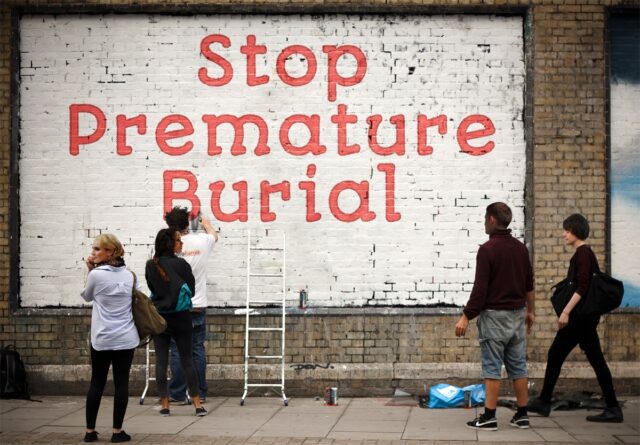PG is not sure how this item might relate to books, but suspects it might be a stimulating writing prompt.
Plus, Haloween
From JSTOR Daily:
Anxiety over being buried alive dates back centuries. Roman author Pliny the Elder remarked: “Such is the condition of humanity, and so uncertain is men’s judgment, that they cannot determine even death itself.” Declaring if someone is dead has not always been easy. There is still debate today over when “legal death” occurs, as the brain can stop functioning while the body remains on life support. The fear of waking up in a mortuary or, worse, a casket, endures. It even has a name: Taphophobia.
This dread reached a crescendo in the nineteenth century, culminating in the 1896 founding of the London Association for the Prevention of Premature Burial. “Blending middle-class unease over Britain’s lax death certification standards with residual working-class worry about defilement at the hands of anatomists, the association labored to publicize the hazards of hasty interment,” the historian George K. Behlmer writes in the Journal of British Studies. The distributed pamphlets related anecdotes about close calls with premature burial. And the association’s members asked Parliament to take action to spare its constituents from this fate. “Their warnings about the nightmarish potential of misdiagnosed death sounded all the more dire to a population that was deeply ambivalent about the ambitions of medical science,” Behlmer adds.
. . . .
An 1898 article in The British Medical Journal on the “prevention of premature burial” lists the protocol for practitioners in Philadelphia in declaring death. It includes holding a mirror or glass under the nostrils of the deceased and touching the skin with “a piece of iron or steel heated red hot for at least the space of ten seconds.” These tactics were not that different from what a doctor may have done in the eighteenth or seventeenth centuries.
Popular literature, such as Edgar Allan Poe’s 1839 “The Fall of the House of Usher” and 1844 “The Premature Burial,” in which the narrator states that “no event is so terribly well adapted to inspire the supremeness of bodily and of mental distress, as is burial before death,” contributed to this fear. The narrator of Poe’s story remodels their family vault with elaborate mechanisms, stores for food, and openings for light and air just in case they are buried alive. Although there were “safety coffins,” or devices to release a wrongly interred person before the nineteenth century, the era saw a new wave of preventative tools to sell.
. . . .
The best way, however, to find out if someone was dead, was rather simple, if unpleasant and time-consuming: wait for them to rot. “The mortuary was created to prevent premature burial,” the historian Marc Alexander writes in The Hastings Center Report. “In the mortuary the corpse could be left to putrefy in hygienic isolation. It could be observed until the last possible moment.” The idea predated the nineteenth-century rise in concern with premature burial: the French physician François Thierry proposed the concept of a mortuary in a 1785 book. Paris opened its mortuary by the turn of that century.
Link to the rest at JSTOR Daily
.

.

.
I had once wondered if the the “lich” part of lichgate (also spelled lychgate) was supposed to have anything to do with this fear, except with the idea of keeping the walking dead inside the cemetery. Since I only knew “lich” in the context of undead sorcerers, I thought a lichgate was supposed to be specially constructed to thwart them.
Eventually, I found out that the purpose of that type of gate was much less exciting than I thought. Still, I think it’s telling that those gates are also called “resurrection gates.”
That’s my writing prompt contribution, as NaNoWriMo kicks off 🙂